This just in: Special Collections acquires monumental work of medieval printing
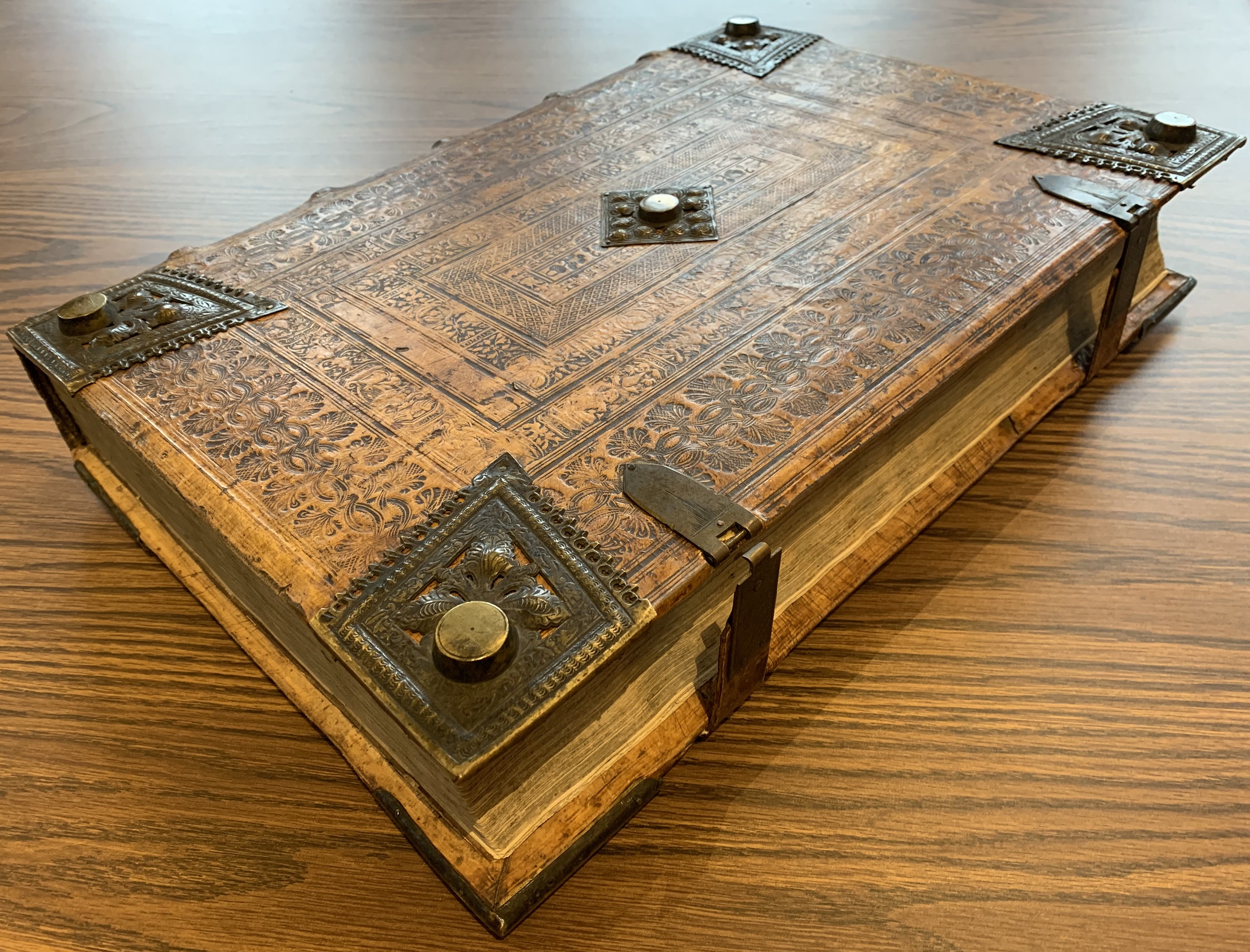
While LSU Football was winding its way through a successful 2020 postseason, Special Collections was enjoying a big win of its own, adding a copy of the large, impressive Nuremberg Chronicle to our rare book collections. Published in 1493 in the German city that gives it its common name, this book represents the height of fifteenth-century book illustration and design. Incorporating over 1800 woodblock illustrations of people, biblical scenes, maps, and cityscapes, it is arguably second in importance only to the Gutenberg Bible in the pantheon of early European printing.
Making this acquisition possible was a substantial grant from the B. H. Breslauer Foundation, which supports significant institutional purchases of rare books, manuscripts, and bookbindings. The monies from the Breslauer Foundation were supplemented by several generous donations from friends of the library, along with the library’s Hauer Rare Book Endowment. Unable to travel to New York City ourselves, we worked through Henry Wessells, agent at James Cummins Bookseller, to place a bid on the book at Swann Auction Galleries' December 17thauction, “Maps & Atlases, Natural History & Color Plate Books.” After more than a little fingernail-chewing while the auction drew on, we eventually received word that our bid had come out on top – and immediately began to make space for the book in our stacks!
[youtube http://www.youtube.com/watch?v=EmOjZRTTmCI]
The publication of the Nuremberg Chronicle, also known in Latin as the Liber Chronicarum, was a watershed moment in the production of European printed books. In the first few years after Johann Gutenberg developed a method of printing using movable metal type in Germany in the middle of the fifteenth century, production runs by printers were small and the books themselves largely resembled their painstakingly handwritten and hand-illustrated brethren.

These books printed in Europe before 1501 are known as ‘'incunables’ or ‘incunabula' (from the Latin meaning ‘swaddling clothes’ or ‘cradle,’ as in, 'printed books in their infancy') because of the visual similarities they have with manuscripts. They are studied for how they materialize this transition from handwritten to printed books, such as the incorporation of woodblock illustrations with handset type.
The printer Anton Koberger was at the forefront of these innovations and drew upon them to prepare the ambitious Chronicle, with its then-unheard-of print run of roughly 1,500 copies. The result is a stunning product, with illustrations of figures, cityscapes, and Biblical scenes twisting through heavy lines of Gothic type, and spilling from one page to the next in a manner bespeaking a level of planning and document design never before seen in Europe. The material product also represents a significant industrial achievement, as the book’s ambitious print run taxed local supplies of raw materials and forced Koberger to add more presses to his enterprise, eventually resulting in a total of twenty-four – a staggering number requiring some one hundred workers when running at full strength. The book is impressively large (almost eighteen inches by a foot in size and just shy of twenty pounds), but it looms even larger when considering its place as the final product of a network of artists, printers, papermakers, and book binders.
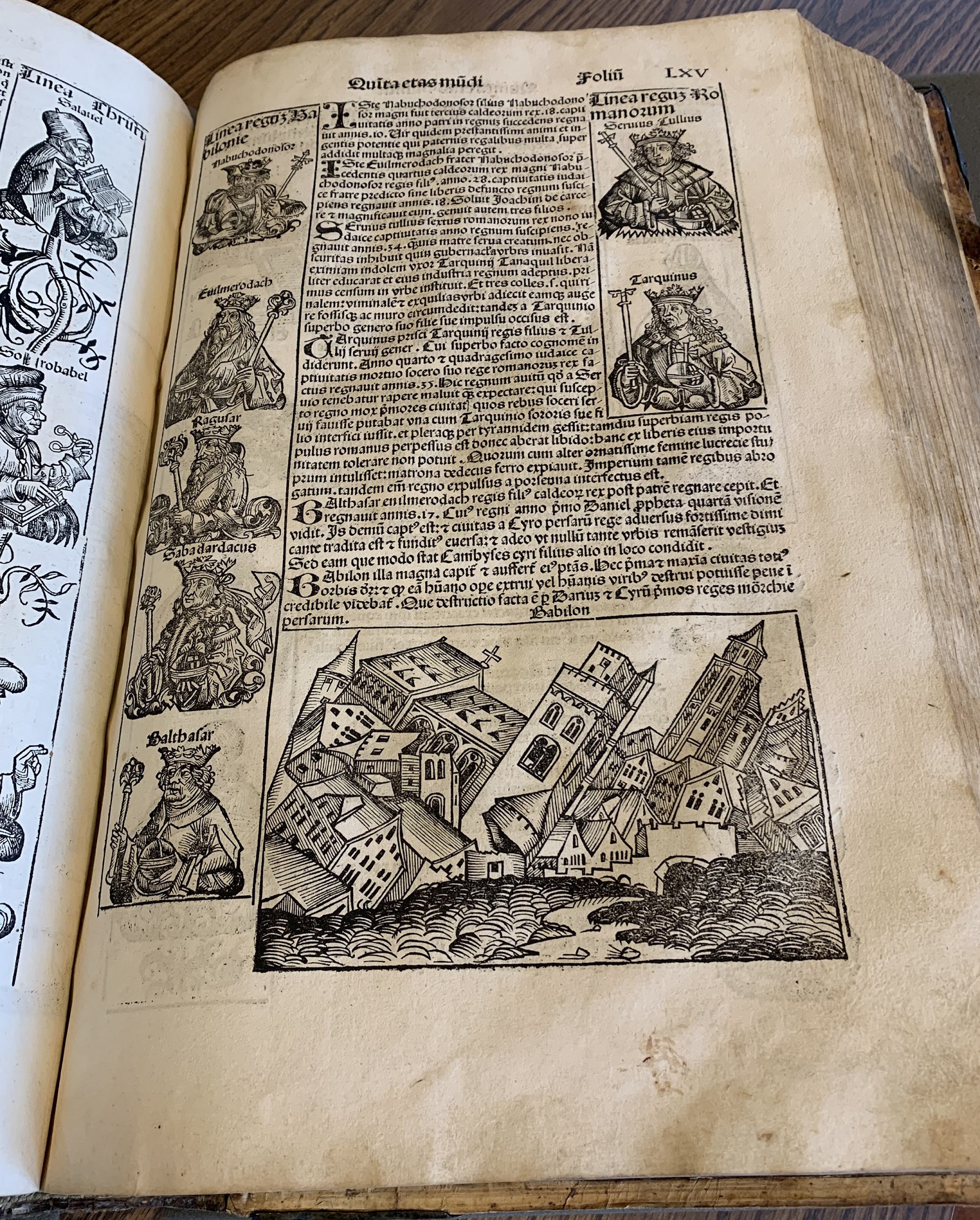
Koberger was the project’s technician, but the woodcut illustrations – the book’s hallmark – were the product of the workshop of Michael Wolgemut, Nuremberg’s leading artist. Wolgemut had in his employ the young Albrecht Dürer, Koberger’s godson, who later established himself as one of the most important figures of the Northern Renaissance of the 16thcentury. The book’s 1,800 illustrations bear scrutiny not only for evidence of Dürer’s humanist hand, lighter and more skilled than that his medieval predecessors, but also because of their economy: roughly 6-700 woodblocks were used throughout the book, meaning that individual blocks were used on average more than three times. Historical and mythical figures were interchanged for one another, some cityscapes stand in for others unchanged, and depictions of church councils are almost gleefully repeated (as if to say that if you’ve seen one committee meeting, you’ve seen ‘em all).
Taken as a whole, however, these technical shortcuts fade in importance, as the sheer number of the illustrations and their skilled placement on the page draw viewers into the book’s rich depiction of its late-medieval world. This is not a book that requires subtle erudition to appreciate, but it instead captivates the seasoned scholar and naïve bibliophile alike.
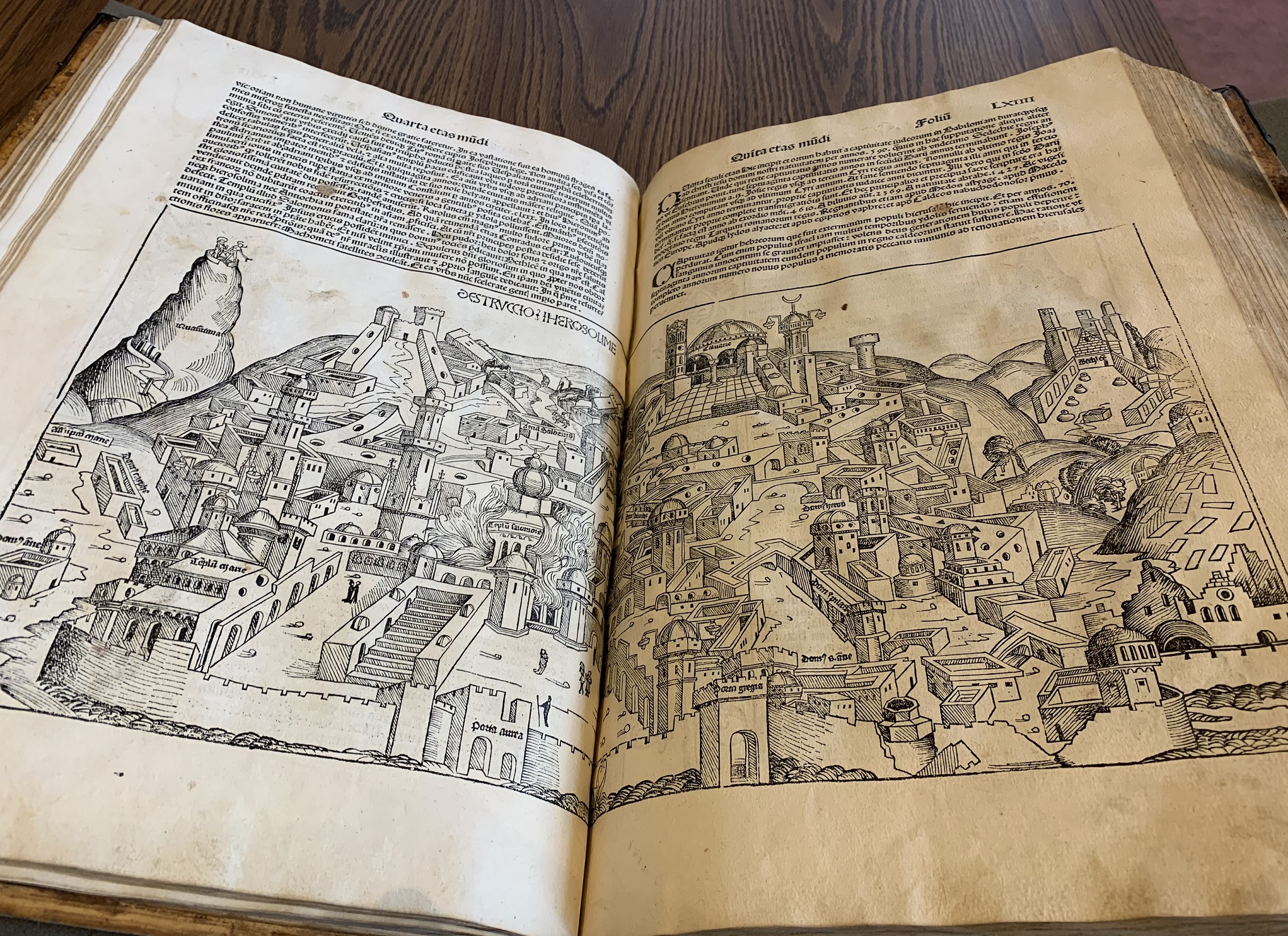
The text of the Nuremberg Chronicle is almost as conventional as its production was innovative. Written by doctor and scholar Hartmann Schedel, it is a history of the world from its biblical past down to the present. It follows the orthodox Christian method for such histories, dividing the past into six ages, beginning with the creation of Adam and ending with speculation on the events of the Book of Revelation in a final, seventh age to come. Schedel lifted most of his work directly from books found in his vast personal library, though he did emphasize the role of Nuremberg and Germany within world history, correcting what he saw as a scholarly bias against his homeland.
Schedel was educated in the Italian city of Padua, and his work is important insofar as it demonstrates Schedel’s importation of Renaissance learning from Italy into Germany, though it might be said that the text itself is better viewed as a historical artifact rather than actual history.
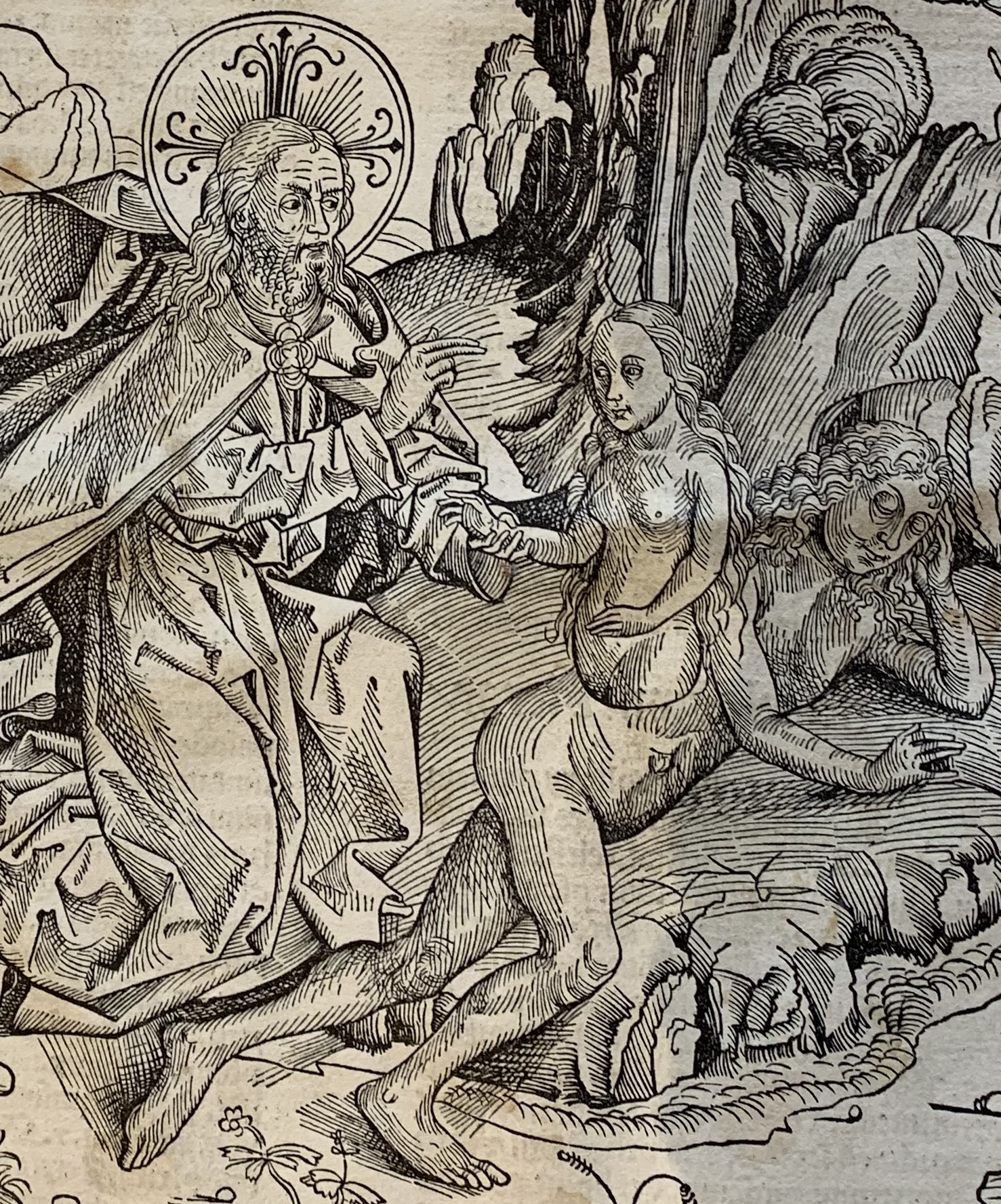
Schedel wrote in Latin, as was the scholarly custom, but a German translation by George Alt followed later in the same year, evidence of a desire to spread knowledge in the vernacular. This version was similarly illustrated using the same woodblocks, and was also popular, though it was printed in an edition roughly half the size of the Latin one. Other pirated editions followed, attesting to the success of Koberger’s original, and thereafter illustrated books measured themselves against this finely crafted archetype. (On the other hand, the book’s text wasn’t fully translated into English until 2011, evidence of its underwhelming content.)
The copy of the Nuremberg Chronicle acquired by Special Collections is in enviable condition, and while it doesn’t have the truly exquisite hand-coloring found on some copies, it is complete – no small feat for a book that often has its illustrations cut out and sold individually – and it boasts a remarkable contemporary binding.
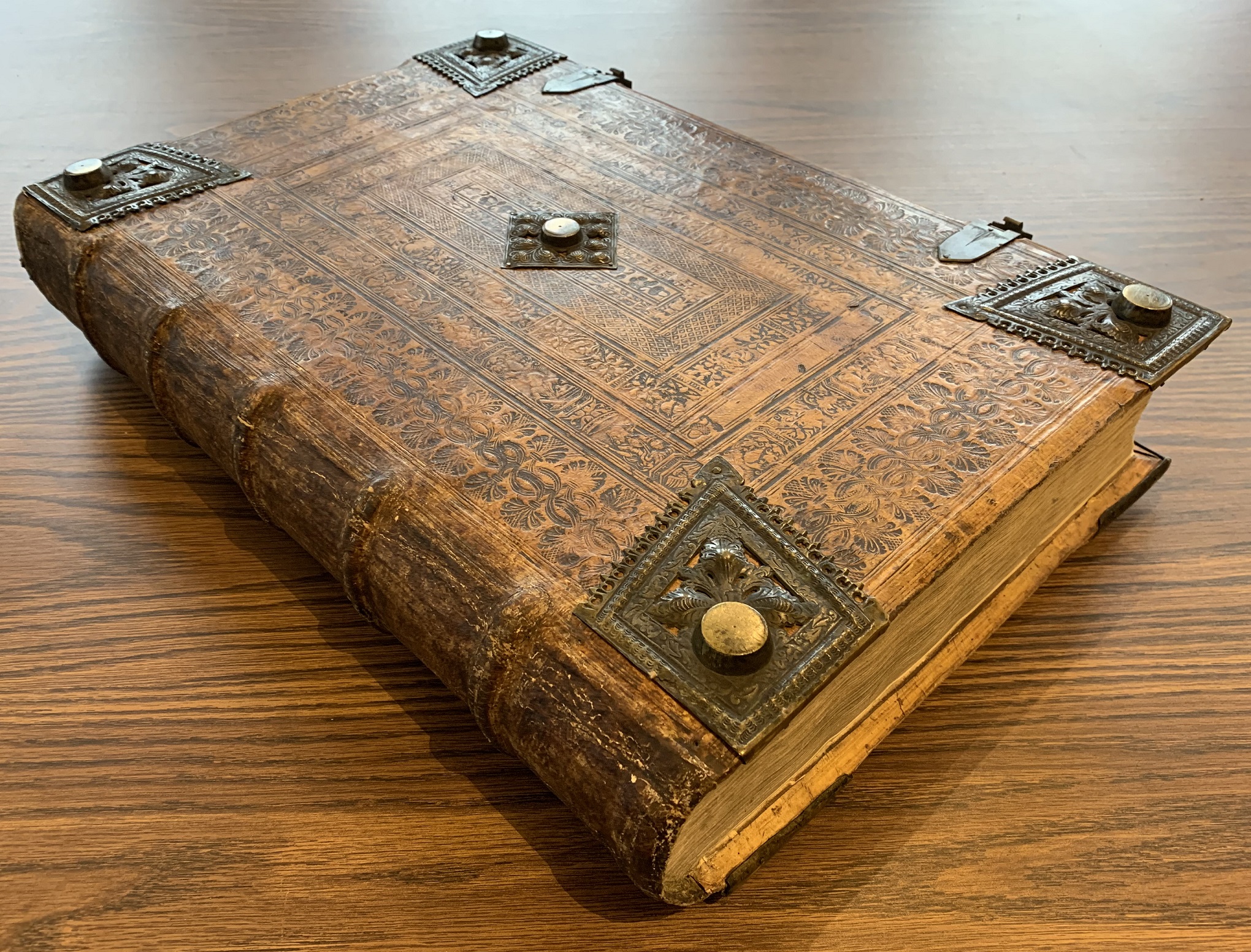
There are marks of use throughout the volume, particularly on pages turned by less-than-archivally-clean hands, and a number of fine repairs are also evident, but generally the book is in spectacular usable form, ready for new generations of readers.
It’s taken this copy of the Nuremberg Chronicle five hundred years to make it to Baton Rouge, but now that it’s here it is eager to make its debut on the bayou. Once the book has been carefully cataloged and housed, it will be available for any patrons in our reading room – come for the woodblock maps and whimsical illustrations, stay for the impressive medieval binding!
[gallery type="slideshow" ids="11930,11940,11941,11931,11932,11933,11936,11939,11937,11938,11934,11943,11935,11942"]
